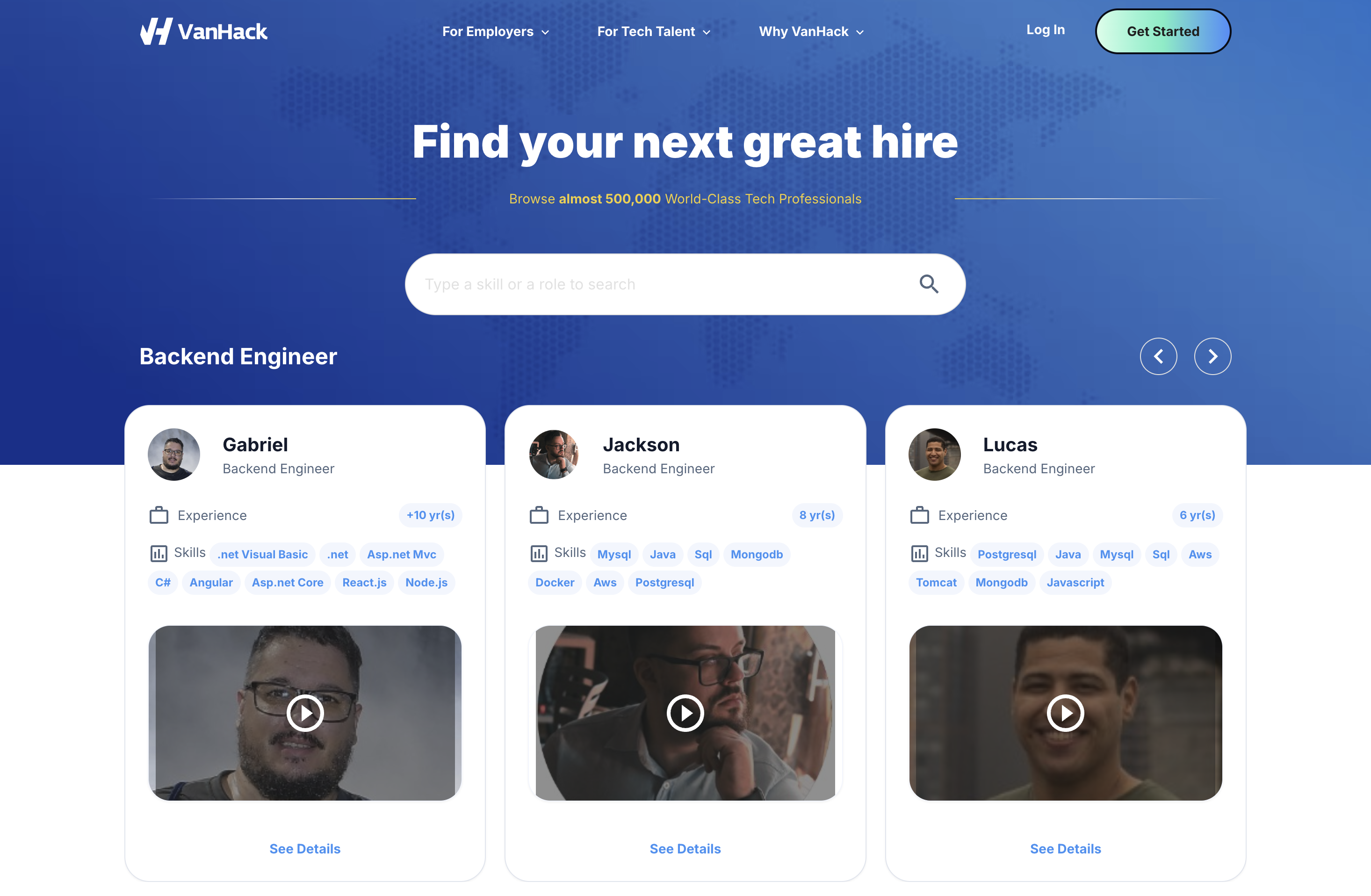Finding and hiring remote developers from Latin America can be a game-changer for US companies, but tracking candidates through the process comes with its own set of challenges. From verifying skills to managing compliance across borders, you need a clear plan to stay on top of it all. This guide offers 7 practical strategies to streamline your job tracking and help you secure top talent with ease. Let’s dive into how you can make remote hiring smoother and more effective. Ready to speed up the process? Hire faster with VanHack.
Why Job Tracking for Remote LATAM Developers Feels Tough
Hiring developers from Latin America brings benefits like access to skilled talent and convenient time zone overlap for US teams. Still, keeping track of candidates in this setup isn’t always straightforward. You often face hurdles like confirming skills, validating credentials, and ensuring accountability. Add to that communication gaps, time differences, and varying legal rules across LATAM countries, and the process can feel overwhelming from start to finish.
Connectivity can also be an issue in some areas, where unstable internet affects virtual interviews and follow-ups. Without a tailored tracking system, you risk delays, misunderstandings, and hires that don’t work out. A focused approach to job tracking helps turn these challenges into opportunities, allowing you to keep candidates moving through your pipeline while minimizing risks in remote hiring.
7 Practical Ways to Streamline Job Tracking with VanHack
1. Use a Centralized System for Managing Global Talent
Keeping everything organized is key when hiring across borders, and a solid Applicant Tracking System (ATS) makes it happen. For remote LATAM developers, pick an ATS with features like global access, time zone support, and flexible workflows to handle international hiring steps. This keeps candidate info, updates, and progress in one place, accessible to your team no matter where they’re based.
Old-school tools like spreadsheets fall short when you’re dealing with candidates from different countries, each with unique legal and communication needs. A modern ATS built for global hiring sets you up for organized, scalable tracking that adapts to these demands.
- Choose an ATS with global features, such as Greenhouse or Workday, to support multiple languages and compliance rules.
- Set up specific pipeline stages like “English Skills Check” or “Country-Specific Compliance Review” for LATAM hires.
- Give your team real-time access and training to ensure consistent data entry.
- Track metrics like time spent in each stage to spot and fix delays in your remote hiring process.
- Use VanHack’s platform for a visual Kanban dashboard, detailed candidate profiles, and easy scheduling.
2. Rely on AI to Match and Screen Candidates Faster
Sorting through applications to find qualified LATAM developers takes time and effort. AI tools can step in to match candidates to your job needs accurately, cut down on bias, and assess skills early on. This works especially well for checking technical abilities and communication without needing hours of manual review.
Unlike basic keyword searches that often miss the mark, AI understands the context of roles and candidate backgrounds, helping you build a stronger pipeline of potential hires.
- Use AI matching tools like VanHack’s “Vanna” to pair candidates with roles based on deeper insights.
- Try AI-driven technical interviews, such as Ripples on VanHack, for recorded sessions and objective scoring.
- Check video introductions on VanHack profiles to quickly gauge English skills and personality.
- Set AI to filter and move top candidates forward, saving time on unqualified applications.
VanHack delivers a shortlist of 3-5 pre-screened candidates using AI and human review, cutting down your workload significantly.
3. Build a Vetting Process for Remote Skills and Cultural Fit
For remote LATAM hires, technical skills are just the start. Success also depends on communication, independence, and adaptability to your team’s culture. Include specific steps in your tracking to assess these remote-ready traits and avoid hires that don’t pan out due to mismatched expectations.
Remote work demands unique abilities compared to office roles. Candidates need to show they can manage their time, communicate clearly, and stay connected despite distance and cultural differences.
- Ask interview questions focused on time management, problem-solving, and remote collaboration.
- Use platforms like Woven or HackerRank for coding challenges tied to your tech needs, with results available through VanHack.
- Assess cultural alignment through interviews to ensure candidates fit with your remote team, considering regional communication styles.
- Check references with a focus on past remote work performance and autonomy.
VanHack’s detailed profiles, including video intros and AI interview results, give you multiple ways to evaluate candidates thoroughly.
4. Simplify Communication with Flexible, Async Tools
Staying in touch with remote LATAM talent can be tricky due to time zones and language differences. Relying only on live calls slows things down. Using asynchronous tools and setting clear communication rules keeps candidates engaged and your team aligned during hiring.
This approach matters even more when language skills vary among candidates, making defined guidelines and scheduling flexibility essential.
- Set up dedicated channels in your ATS or tools like Slack for consistent candidate updates.
- Use platforms like Notion or Trello to share feedback and track internal decisions.
- Define expected response times for candidates and team members to keep things moving.
- Send short video updates via tools like Loom to clarify complex points, especially with connectivity challenges in LATAM.
- Clearly state English skill requirements and offer support resources if needed.
5. Tackle Compliance and Mobility Checks from the Start
Hiring remotely from LATAM means dealing with local labor laws, taxes, and sometimes immigration rules. Waiting too long to address these can cause delays or legal headaches. Build compliance checks into your tracking process early to stay on track and avoid surprises.
Rules and requirements differ across LATAM, so your system needs to account for country-specific regulations. Handling this alone can be a lot for any team.
- Add an early “Mobility and Compliance” stage in your ATS to catch issues before investing time.
- Work with global mobility experts like VanHack’s in-house team to handle visas and logistics.
- Set up your ATS to flag missing compliance documents tailored to each country.
- Consult legal advisors on LATAM labor laws to ensure contracts and processes are sound.
6. Align Schedules with Overlapping Work Hours
Many LATAM countries share similar time zones with the US, but you still need a plan to coordinate effectively. Setting up overlapping hours and smart scheduling helps avoid delays in interviews and ensures support during onboarding while respecting everyone’s time.
Good time zone planning keeps the hiring process moving and maintains candidate interest, as clear schedules and tools are vital for remote collaboration.
- Define 3-4 daily “core hours” for live meetings that work for both US and LATAM time zones.
- Use scheduling tools that adjust for time differences and suggest convenient slots.
- Explain your collaboration expectations to candidates early in the process.
- Display candidate local times in your ATS to help recruiters plan without errors.
7. Partner with Experts for Full Job Tracking Support
For growing companies, handling every aspect of job tracking internally, from sourcing to onboarding, can drain resources. Working with a specialized recruitment partner gives you access to experience, networks, and tools to simplify the process while connecting you with pre-screened talent you might not find on your own.
Managing multiple strategies at once often stretches internal teams thin, especially when core business tasks need attention. A trusted partner offers ready-made solutions without the hassle of building them yourself.
- Check if your team has the capacity and know-how to manage global hiring alone.
- Team up with a focused expert like VanHack, specializing in LATAM tech talent for remote roles with tools for vetting and mobility.
- Free up your staff to focus on final interviews while the partner handles early stages.
- Gain from a full set of services, covering sourcing to visa support, in one platform.
VanHack lets you focus on key decisions while they manage initial tracking, offering unlimited hires for a flat $3,000 monthly fee. Ready to improve your hiring flow? Start with VanHack today.
VanHack: Your Ally for Hiring Remote LATAM Talent
Tracking candidates for remote LATAM developer roles takes a mix of tech, structure, and global insight. Each strategy in this guide adds value, but combining them creates a powerful hiring approach. VanHack makes this easier by providing a complete solution, handling everything from AI candidate matching to mobility support.

- AI Matching with “Vanna” delivers a shortlist of 3-5 matched candidates, saving screening time.
- Detailed profiles include video intros, AI interview scores, and coding results for better insights.
- Built-in mobility services manage visas and relocation, reducing paperwork stress.
- A flat $3,000 monthly fee covers unlimited hires, making scaling cost-effective.
Looking to connect with skilled developers? Explore talent with VanHack and simplify remote hiring.
Common Questions About Hiring Remote LATAM Developers
What Makes Tracking LATAM Remote Hires Different from Local Ones?
Tracking remote LATAM developers involves verifying skills and credentials, managing time zone and communication differences, and complying with diverse local laws and taxes. Unreliable internet in some areas can also disrupt virtual processes. Cultural differences may lead to misunderstandings if systems aren’t built to address them. These factors call for specialized vetting, communication plans, and compliance steps that local hiring doesn’t typically require.
How Does AI Help with Tracking International Candidates?
AI boosts efficiency by matching candidates to roles automatically, assessing skills objectively, and streamlining early vetting. It goes beyond simple keyword searches to grasp role details and candidate fit. Tools like AI interviews provide recordings and scores for flexible review, cutting down initial screening time. Automated shortlisting ensures only qualified candidates move forward, saving recruiters from reviewing unsuitable applications manually.
Why Is Cultural Fit Important for Remote LATAM Hires?
Cultural fit affects team unity, communication, and retention for remote LATAM developers. Tracking should include steps to evaluate comfort with remote tools, independence, and adaptability to a diverse team. Checking how candidates handle different work styles and company values matters too. Without alignment, issues like miscommunication or reduced output can arise, so assessing both skills and fit is key for lasting success.
How Does VanHack Make Tracking Easier for US Companies?
VanHack simplifies tracking by managing sourcing, pre-screening, AI matching, and mobility support. They offer a shortlist of qualified candidates, cutting down application reviews. Their platform centralizes tools like video intros and coding results for easy assessment. They also handle compliance and immigration tasks, letting US teams focus on final interviews instead of complex admin work tied to LATAM hiring.
What Compliance Steps Should Be Part of Tracking LATAM Hires?
Tracking for LATAM hires needs to cover local labor laws, tax rules, data privacy, and contract standards, which differ by country. Monitor required documents, classify workers correctly, and manage tax reporting per region. For potential relocation, check visa needs early. Payment, benefits, and termination rules also vary, so include these in your workflow to prevent legal issues and keep hiring smooth.
Final Thoughts: Access Top Talent with Better Tracking
Hiring remote LATAM developers calls for a thoughtful tracking approach that traditional methods can’t match. Using these 7 strategies, from AI matching to expert partnerships, helps US companies handle international hiring with confidence and speed.
These steps work together to build a strong hiring framework that finds and places the right talent. Remote LATAM hiring often needs tools and expertise most teams don’t have internally. While you can apply these ideas on your own, partnering with a platform like VanHack offers a complete solution.
VanHack supports your hiring with AI tools, regional knowledge, and mobility services to tackle tracking challenges. Don’t let outdated methods hold you back from great talent. Ready to upgrade your remote hiring? Connect with skilled developers now through VanHack’s platform.



